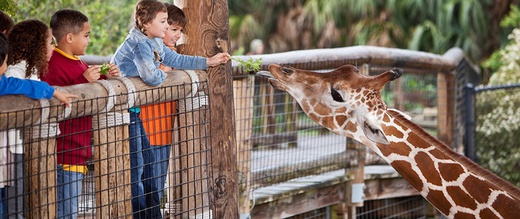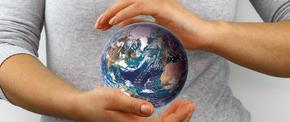The views expressed in our content reflect individual perspectives and do not represent the authoritative views of the Baha'i Faith.
All of the photos and videos of cute baby animals that people seem to love so much on the web—it turns out, say the scientists, that we’re really hard-wired to love cuteness.
The famed Austrian ethologist and Nobel Laureate Konrad Lorenz, who studied the evolutionary and adaptive significance of behavior in humans and animals, said that many baby animals have features shared by human babies—button noses, large foreheads, big eyes and a retreating chin. Lorenz wrote, after he noticed this similarity (and long before all those Facebook posts of cute baby animals), that humans have a naturally evolved, highly emotional response to our human young—and that we transfer our emotional reactions when we see the same kinds of features in other young mammals.
Make sense?
Wouldn’t it also make sense, then, for us as human beings to value some of the most praiseworthy animal behaviors? And to transfer them to our human activities?
The Baha’i writings point out, in several places, that the virtuous, peaceful and cooperative behavior of animals often exceeds and improves upon the behaviors of people:
Domestic animals live with their kind in peace and harmony. If you bring together sheep from various countries, from France, Persia, America, etc., not one would contend: “I am a Persian sheep,” or “I am an American sheep.” Let us at least live together as these animals would. Is it fitting that we should be more savage than they? Again, if you collect in one room doves from Asia, Europe, Africa, America and Australia, cooingly they will love one another. – Abdu’l-Baha, Divine Philosophy, p. 182.
If only, Abdu’l-Baha suggests, people from different places could co-exist and love one another as well as a flock of sheep or doves. He extends the metaphor even further in this story:
In some animals mutual co-operation is frequently seen; when in time of danger, each will try to surpass the others in help. One day as I was standing near the border of a little stream on Mt. Carmel, I noticed a number of locusts that had not yet developed full wings.
These insects wishing to pass from my side of the stream to the other in order to procure some food, threw themselves forward, each one trying to emulate the other in flinging itself into the water, so that a bridge was formed in order that the others might pass over and this was accomplished; yet those who gave themselves as a bridge finally perished. Consider how much solidarity makes for life as compared to the fighting for self-interest which destroys it. – Abdu’l-Baha, Divine Philosophy, p. 187.
The Baha’i teachings urge this kind of cooperative solidarity on all people. Unity, the primary theme and principle of the Baha’i Faith, emphasizes the powerful potential of human wholeness. We can come together, like the doves do, as one species:
When you enter a rose-garden the wealth of color and variety of floral forms spread before you a picture of wonder and beauty. The world of humanity is like a garden and the various races are the flowers which constitute its adornment and decoration. In the animal kingdom also we find variety of color. See how the doves differ in beauty yet they live together in perfect peace, and love each other. They do not make difference of color a cause of discord and strife. They view each other as the same species and kind. They know they are one in kind. Often a white dove soars aloft with a black one. Throughout the animal kingdom we do not find the creatures separated because of color. They recognize unity of species and oneness of kind. If we do not find color distinction drawn in a kingdom of lower intelligence and reason, how can it be justified among human beings, especially when we know that all have come from the same source and belong to the same household? In origin and intention of creation mankind is one. – Abdu’l-Baha, Foundations of World Unity, p. 34.
 So it turns out, strangely enough, that we can learn an enormous amount from those cute baby animals we see online. They may seem silly, mundane and mawkish—but their adorable qualities carry an underlying message that touches something deep in our psyche. We can mimic their kind, peaceful, harmonious interaction with one another. We can find ways to cross borders and boundaries and learn to love those we previously avoided. We can realize our essential oneness and actually find joy in it. Rather than acting in the territorial, belligerent and aggressive manner of nature’s predator species, we can immediately find ways to associate with each other in harmony:
So it turns out, strangely enough, that we can learn an enormous amount from those cute baby animals we see online. They may seem silly, mundane and mawkish—but their adorable qualities carry an underlying message that touches something deep in our psyche. We can mimic their kind, peaceful, harmonious interaction with one another. We can find ways to cross borders and boundaries and learn to love those we previously avoided. We can realize our essential oneness and actually find joy in it. Rather than acting in the territorial, belligerent and aggressive manner of nature’s predator species, we can immediately find ways to associate with each other in harmony:
Consider! The blessed animals engage in no patriotic quarrels. They are in the utmost fellowship with one another and live together in harmony. For example, if a dove from the east and a dove from the west, a dove from the north and a dove from the south chance to arrive, at the same time, in one spot, they immediately associate in harmony. So is it with all the blessed animals and birds. But the ferocious animals, as soon as they meet, attack and fight with each other, tear each other to pieces and it is impossible for them to live peaceably together in one spot. They are all unsociable and fierce, savage and combative fighters. – Abdu’l-Baha, Selections from the Writings of Abdu’l-Baha, p. 301.

















Comments
Sign in or create an account
Continue with Facebookor